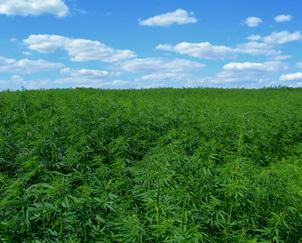
3 minute read
5 Cool Ways Plants Are Used For Textiles
It’s no secret the textile industry is terrible for the environment, linked to high energy and water use, greenhouse gas emissions, and water pollution. According to numbers by Waste Reduction Week in Canada, the global textile industry uses one trillion kilowatt-hours every year; 10% of the world’s total carbon impact. It takes 2,650 liters of water to make a single cotton t-shirt, and dying and treating textiles contribute up to 20% of total industrial water pollution.
Brilliant minds are coming up with ways to reduce the industry’s environmental footprint. Here’s our list of the 5 cool ways plants are being used for textiles.
1. Vegetable Cashmere

It looks like cashmere; it feels like cashmere; only, it has nothing to do with goats. Vegetable cashmere is an all-natural fabric created from the soybean plant. The 100% biodegradable alternative to animal fiber is made with soy protein spun from the pulp in tofu production; that’s it, that’s all. Soft, silky, and stretchy, the fabric is full of plant proteins that nourish the skin and is currently being used to make yoga, active, and loungewear. Design brand KD New York claims that much like animal-based cashmere, this one keeps you warm in the winter and comfortable in the heat.
Learn more about Vegetable Cashmere: bit.ly/347UiBd
2. SeaCell

Seaweed has long held a reputation as being a superfood; now, the marine plant is breaking into the fashion and textile industry. Producing SeaCell is eco-friendly. Also known as the Lyocell process, it takes place in a closed loop with no chemicals released as waste. Seaweed is pressed into a natural cellulose fiber, preserving all of its beneficial properties along the way. Essential vitamins, amino acids and minerals transfer between the fiber and the skin, helping activate cell regeneration and protect from free radicals. Made exclusively for smartfiber AG, the fabric is described as silky smooth and comfortable, perfect for athletic and loungewear, undergarments, and home textiles.
3. Piñatex
Learn more about SeaCell: smartfiber.de

Love the luxurious look and feel of leather but want to spare animals and the planet? Piñatex is the perfect guiltfree alternative! Dr. Carmen Hijosa, a leather goods expert, developed the product and founded Ananas Anam after witnessing the environmental destruction associated with leather production. Piñtex is made with the fiber from the leaves of the pineapple plant, which are discarded after harvest, anyway. Once the leaves are stripped of their fiber, the leftover biomass is turned into nutrient-rich fertilizer or biofuel. How’s that for zero-waste? The pineapple fibers undergo a process to become a non-woven mesh that is soft, flexible, durable, and looks just like leather. The product has so far been used in footwear, fashion accessories, clothing, furniture, and car upholstery.
Learn more about Piñatex: ananas-anam.com

4. Flora Fur

Milkweed and linen combine to create water-resistant garments.
Inspired by nature for nature, flora fur is the world’s first garden-grown fur combing milkweed and linen to create warm and water-resistant garments. The brainchild of a team of students at New York’s F.I.T., the soft yarn is 100% biodegradable and looks and feels just like real fur but without the cruelty. Beyond saving the lives of animals and eliminating the microplastics faux fur sheds into the environment, this alternative is doing a world of good for the depleting population of monarch butterflies. The caterpillars only eat milkweed, and flora fur is encouraging its growth on sustainable farms. The monarchs call the farms home during the spring and summer, and by the time it’s time to harvest the milkweed pods, the butterflies are migrating south.
Win-win! Learn more about flora fur: florafur.com
5. Hemp

Of course, we would be remiss if we didn’t mention hemp in our list of sustainable textiles! It’s used for everything from clothing and fashion accessories to home and hardware products; hemp is even considered a viable and eco-friendly alternative to wood and other building materials. The products made with the plant are soft like linen, are naturally resistant to bacteria, and are 100% biodegradable. Hemp crops grow quickly and without the use of any pesticides or chemicals; its roots stretch deep into the soil and protect it from erosion while also continuing to build and preserve it. From environmental protection to food and textiles, hemp has so many bases covered.
Learn more about hemp: hemptrade.ca










